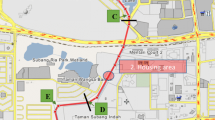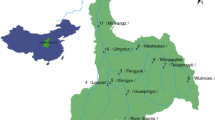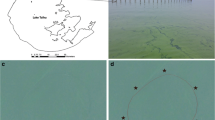Abstract
The relationship between land use and microbial community structure at seven sites along the Lower Mekong River, between Thailand and the Loa People’s Democratic Republic, was investigated using Illumina next-generation sequencing of the V5–V6 hypervariable regions of the 16S rRNA gene. In total, 14,470 operational taxonomic units (OTUs) were observed. Community composition was significantly different between sampling years. Moraxellaceae and Comamonadaceae were the predominant bacterial families in upstream sites, which included agricultural and urban areas in the Loei and Nong Khai provinces of Thailand. Members of the family Comamonadaceae were prevalent in agricultural and urban sites in Bueng Kan Province, while Moraxellaceae and Burkholderiaceae were the major families in a site downstream of an urban area in the Nakhon Phanom Province of Thailand. The bacterial community observed from a forested area of Patam National Park in Thailand showed greatest diversity, and several major bacterial families including Comamonadaceae, Moraxellaceae, and Pseudomonadaceae were more dominant than other sites. The diversity of fecal indicator bacteria, determined by ERIC-PCR DNA fingerprinting, indicated the presence of 29 strains of Escherichia coli and 21 strains of Enterococcus, while TP-RAPD patterns represented six species of Enterococcus. Results of this study indicated that although the difference in the distribution of bacterial phyla and families was found among sampling sites, the bacterial community composition, based on the presence of OTUs, continuously retained its signature across approximately 758 km along the Lower Mekong River, regardless of the type of land use. Water parameters, including temperature, turbidity, DO, and air temperature, also differentially affected the abundance of bacterial families along the Mekong River.






Similar content being viewed by others
References
Alfouzan, W., Al-Sheridah, S., Al-Jabban, A., Dhar, R., Al-Mutairi, A. R., & Udo, E. (2014). A case of multiple splenic abscesses due to Enterococcus hirae. JMM Case Reports. https://doi.org/10.1099/jmmcr.0.001214
American Public Health Association (APHA). (2012). Standard methods for the examination of water and wastewater. Washington, DC: APHA.
Arvanitidou, M., Katsouyannopoulos, V., & Tsakris, A. (2001). Antibiotic resistance patterns of enterococci isolated from coastal bathing waters. Journal of Medical Microbiology, 50(11), 1001–1005.
Begg, A. P., Todhunter, K., Donahoe, S. L., Krockenberger, M., & Slapeta, J. (2014). Severe amoebic placentitis in a horse caused by an Acanthamoeba hatchetti isolate identified using next-generation sequencing. Journal of Clinical Microbiology, 52(8), 3101–3104.
Beier, S., Witzel, K. P., & Marxsen, J. (2008). Bacterial community composition in central European running waters examined by temperature gradient gel electrophoresis and sequence analysis of 16S rRNA genes. Applied and Environmental Microbiology, 74(1), 188–199.
Bray, J. R., & Curtis, J. T. (1957). An ordination of the upland forest communities of southern Wisconsin. Ecological Monographs, 27(4), 325–349.
Byappanahalli, M. N., Roll, B. M., & Fujioka, R. S. (2012). Evidence for occurrence, persistence, and growth of Escherichia coli and enterococci in Hawaii’s soil environments. Microbes and Environment, 27(2), 164–170.
Claesson, M. J., Wang, Q. O., O’Sullivan, O., Greene-Diniz, R., Cole, J. R., Ross, R. P., et al. (2010). Comparison of two next-generation sequencing technologies for resolving highly complex microbiota composition using tandem variable 16S rRNA gene regions. Nucleic Acids Research, 38(22), e200.
Clarke, K. R. (1993). Non-parametric multivariate analyses of changes in community structure. Austral Ecology, 18(1), 117–143.
Deasy, B. M., Rea, M. C., Fitzgerald, G. F., Cogan, T. M., & Beresford, T. P. (2000). A rapid PCR based method to distinguish between Lactococcus and Enterococcus. Systematic and Applied Microbiology, 23(4), 510–522.
Department of Water Resources, Thailand. (2016). 2015 Mekong water quality monitoring in Thailand report. Bangkok: Department of Water Resources, Thailand.
European Committee for Antimicrobial Susceptibility Testing (EUCAST). (2003). Determination of minimum inhibitory concentrations (MICs) of antibacterial agents by broth dilution. Clinical Microbiology and Infection, 9(8), ix–xv.
Excoffier, L., Smouse, P. E., & Quattro, J. M. (1992). Analysis of molecular variance inferred from metric distances among DNA haplotypes-application to human mitochondrial DNA restriction data. Genetics, 131(2), 479–491.
Greater Mekong Subregion Development Analysis Network (GMS-DAN). (2014). Inclusive development in the greater Mekong subregion: an assessment. Phnom Penh: GMS-DAN https://www.cdri.org.kh/publication-page-old/pub/dan/gmsdan9a.pdf. Accessed 12 July 2018.
Ibekwe, A. M., Leddy, M. B., Bold, R. M., & Graves, A. K. (2012). Bacterial community composition in low-flowing river water with different sources of pollutants. FEMS Microbiology Ecology, 79(1), 155–166.
Ibekwe, A. M., Ma, J., & Murinda, S. E. (2016). Bacterial community composition and structure in an urban river impacted by different pollutant sources. The Science of the Total Environment, 566-567, 1176–1185.
Jackson, C., Fedorka-Cray, P., & Barrett, J. (2004). Use of a genus- and species-specific multiplex PCR for identification of enterococci. Journal of Clinical Microbiology, 42(8), 3558–3565.
Johnston, L. M., & Jaykus, L. A. (2004). Antimicrobial resistance of Enterococcus species isolated from produce. Applied and Environmental Microbiology, 70(5), 3133–3137.
Korajkic, A., McMinn, B. R., Shanks, O. C., Sivaganesan, M., Fout, G. S., & Ashbolta, N. J. (2014). Biotic interactions and sunlight affect persistence of fecal indicator bacteria and microbial source tracking genetic markers in the Upper Mississippi River. Applied and Environmental Microbiology, 80(13), 3952–3961.
Kummu, M., & Varis, O. (2007). Sediment-related impacts due to upstream reservoir trapping, the Lower Mekong River. Geomorphology, 85(3–4), 275–293.
Liu, P., Soupir, M. L., Zwonitzer, M., Huss, B., & Jorboe, L. R. (2011). Association of antibiotic resistance in agricultural Escherichia coli isolates with attachment to quartz. Applied and Environmental Microbiology, 77(19), 6945–6953.
Lozupone, C., & Knight, R. (2005). UniFrac: a new phylogenetic method for comparing microbial communities. Applied and Environmental Microbiology, 71(12), 8228–8235.
MacAlister, C., & Mahaxay, M. (2009). Mapping wetlands in the Lower Mekong Basin for wetland resource and conservation management using Landsat ETM images and field survey data. Journal of Environmental Management, 90(7), 2130–2137.
Massoud, M. A., El-Fadel, M., Scrimshaw, M. D., & Lester, J. N. (2006). Factors influencing development of management strategies for the Abou Ali River in Lebanon I: spatial variation and land use. Science of the Total Environment, 362(1–3), 15–30.
Mekong River Commission (MRC). (2010). State of the basin report 2010. Vientiane: MRC.
Mekong River Commission (MRC). (2011). Planning atlas of the Lower Mekong River basin. Vientiane: MRC.
Mekong River Commission (MRC). (2016). 2014 Lower Mekong regional water quality monitoring report. Vientiane: MRC.
Mercat, M., Clermont, O., Massot, M., Ruppe, E., de Garine-Wichatitsky, M., Miguel, E., et al. (2016). Escherichia coli population structure and antibiotic resistance at a buffalo/cattle interface in southern Africa. Applied and Environmental Microbiology, 82(5), 1459–1467.
Nowrousian, M. (2010). Next-generation sequencing techniques for eukaryotic microorganisms: sequencing-based solutions to biological problems. Eukaryotic Cell, 9(9), 1300–1310.
Okeke, I. N., Fayinka, S. T., & Lamikanra, A. (2000). Antibiotic resistance in Escherichia coli from Nigerian students, 1986-1998. Emerging Infectious Diseases, 6(4), 393–396.
Olorunmola, F. O., Kolawole, D. O., & Lamikanra, A. (2013). Antibiotic resistance and virulence properties in Escherichia coli strains from cases of urinary tract infections. African Journal of Infectious Diseases, 7(1), 1–7.
Pandey, P. K., Kass, P. H., Soupir, M. L., Biswas, S., & Singh, V. P. (2014). Contamination of water resources by pathogenic bacteria. AMB Express, 4, 51–67.
Pongsilp, N. (2012). Phenotypic and genotypic diversity of rhizobia. Sharjah: Bantham Science Publishers.
Ran, Q., Badgley, B. D., Dillon, N., Dunny, G. M., & Sadowsky, M. J. (2013). Occurrence, genetic diversity, and persistence of enterococci in a Lake Superior watershed. Applied and Environmental Microbiology, 79(9), 3067–3075.
Riboldi, G. P., Frazzon, J., d’Azevedo, P. A., & Frazzon, A. P. G. (2009). Antimicrobial resistance profile of Enterococcus spp. isolated from food in southern Brazil. Brazilian Journal of Microbiology, 40(1), 125–128.
Rivas, R., Velazquez, E., Willems, A., Vizcaíno, N., Subba-Rao, N. S., Mateos, P. F., et al. (2002). A new species of Devosia that forms a unique nitrogen fixing root-nodule symbiosis with the aquatic legume Neptunia natans (L.f.) Druce. Applied and Environmental Microbiology, 68(11), 5217–5222.
Saenz, Y., Brinas, L., Domínguez, E., Ruiz, J., Zarazaga, M., Vila, J., et al. (2004). Mechanisms of resistance in multiple-antibiotic-resistant Escherichia coli strains of human, animal, and food origins. Antimicrobial Agents and Chemotherapy, 48(10), 3996–4001.
Salipante, S. J., Kawashima, T., Rosenthal, C., Hoogestraat, D. R., Cummings, L. A., Sengupta, D. J., et al. (2014). Performance comparison of Illumina and Ion Torrent next generation sequencing platforms for 16S rRNA-based bacterial community profiling. Applied and Environmental Microbiology, 80(24), 7583–7591.
Schloss, P. D., Westcott, S. L., Ryabin, T., Hall, J. R., Hartmann, M., Hollister, E. B., et al. (2009). Introducing mothur: open-source, platform-independent, community-supported software for describing and comparing microbial communities. Applied and Environmental Microbiology, 75(23), 7537–7541.
Sekiguchi, H., Watanabe, M., Nakahara, T., Xu, B., & Uchiyama, H. (2002). Succession of bacterial community structure along the Changjiang River determined by denaturing gradient gel electrophoresis and clone library analysis. Applied and Environmental Microbiology, 68(10), 5142–5150.
Simek, K., Pernthaler, J., Weinbauer, M. G., Hornak, K., Dolan, J. R., Nedoma, J., et al. (2001). Changes in bacterial community composition and dynamics and viral mortality rates associated with enhanced flagellate grazing in a mesoeutrophic reservoir. Applied and Environmental Microbiology, 67(6), 2723–2733.
Staley, C., Unno, T., Gould, T. J., Jarvis, B., Phillips, J., Cotner, J. B., et al. (2013). Application of Illumina next-generation sequencing to characterize the bacterial community of the Upper Mississippi River. Journal of Applied Microbiology, 115(5), 1147–1158.
Tadesse, D. A., Zhao, S., Tong, E., Ayers, S., Singh, A., Bartholomew, M. J., et al. (2012). Antimicrobial drug resistance in Escherichia coli from humans and food animals, United States, 1950-2002. Emerging Infectious Diseases, 18(5), 741–749.
Trivedi, K., Cupakova, S., & Karpiskova, R. (2011). Virulence factors and antibiotic resistance in enterococci isolated from food-stuffs. Veterinární Medicína, 56(7), 352–357.
Ulrich, N., Rosenberger, A., Brislawn, C., Wright, J., Kessler, C., Toole, D., et al. (2016). Restructuring of the aquatic bacterial community by hydric dynamics associated with superstorm sandy. Applied and Environmental Microbiology, 82(12), 3525–3526.
United States Environmental Protection Agency (U.S. EPA). (2002). Method 1103.1: Escherichia coli (E. coli) in water by membrane filtration using membrane-thermotolerant Escherichia coli agar (mTEC). Washington, DC: U.S. EPA.
United States Environmental Protection Agency (U.S. EPA). (2006). Method 1600: Enterococci in water by membrane filtration using membrane-Enterococcusindoxyl-β-D-glucoside agar (mEI). Washington, DC: U.S. EPA.
Valverde, A., Igual, J. M., Peix, A., Cervantes, E., & Velazquez, E. (2006). Rhizobium lusitanumsp. nov. a bacterium that nodulates Phaseolus vulgaris. International Journal of Systematic and Evolutionary Microbiology, 56(Pt 11), 2631–2637.
Versalovic, J., Koeuth, T., & Lupski, J. R. (1991). Distribution of repetitive DNA sequences in eubacteria and application to fingerprinting of bacterial genomes. Nucleic Acids Research, 19(24), 6823–6831.
Vincy, M. V., Brilliant, R., & Pradeepkumar, A. P. (2017). Prevalence of indicator and pathogenic bacteria in a tropical river of Western Ghats, India. Applied Water Science, 7, 833–844.
Weiskel, P. K., Howes, B. L., & Heufelder, G. R. (1996). Coliform contamination of a coastal embayment: sources and transport pathways. Environmental Science & Technology, 4(6), 1872–1881.
Wetzel, R. G. (2001). Limnology: lake and river ecosystems. London: Academic Press.
Wheeler, A., Hartel, P., Godfrey, D., Hill, J., & Segars, W. (2002). Potential of Enterococcus faecalis as a human fecal indicator for microbial source tracking. Journal of Environmental Quality, 31(4), 1286–1293.
Yergeau, E., Lawrence, J. R., Sangschagrin, S., Waiser, W. J., Korber, D. R., & Greer, C. W. (2012). Next-generation sequencing of microbial communities in the Athabasca River and its tributaries in relation to oil sands mining activities. Applied and Environmental Microbiology, 78(21), 7626–7637.
Acknowledgements
This work was supported, in part, by the Silpakorn University Research and Development Institute under Grant SURDI 59/01/42 (to NP) and by the University of Minnesota Agricultural Experiment Station (to MJS). Sequence processing and analyses were performed using the resource of the Minnesota Supercomputing Institute at the University of Minnesota.
Author information
Authors and Affiliations
Corresponding author
Rights and permissions
About this article
Cite this article
Staley, C., Pongsilp, N., Nimnoi, P. et al. Influence of Physicochemical Factors on Bacterial Communities Along the Lower Mekong River Assessed by Illumina Next-Generation Sequencing. Water Air Soil Pollut 229, 321 (2018). https://doi.org/10.1007/s11270-018-3973-0
Received:
Accepted:
Published:
DOI: https://doi.org/10.1007/s11270-018-3973-0




